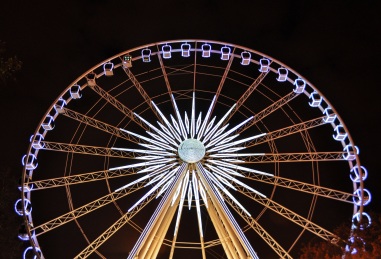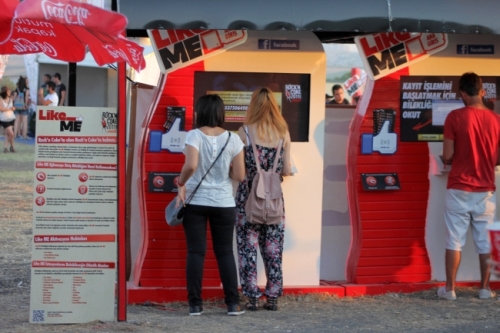RFID Wristbands Used For Fun and Games: Event Management, Cashless Payments, and Social Sharing
 If you've ever gone to the local fair, spent the day at an amusement park, or attended an outdoor music festival, you've probably worn one of those paper admission wristbands that seem almost impossible to get off at the end of the day.
If you've ever gone to the local fair, spent the day at an amusement park, or attended an outdoor music festival, you've probably worn one of those paper admission wristbands that seem almost impossible to get off at the end of the day.
And since these admit-one wristbands don't seem to remove much of the workload for event staff and organizers, you might wonder if there's a better way to manage visitors.
Many event managers are turning to RFID wristbands to handle the challenges associated with large groups of people. The wristbands serve as entry tickets, electronic payment sources, and even social media connections. And as the costs of RFID wristband technology decrease, more and more companies in a variety of industries are adopting it. Here are some recent examples.
✓ Guests at Great Wolf Lodge waterpark resorts in the United States already use RFID-enabled wristbands as room keys and in-house charge accounts, but now the property in Grand Mound, Washington is set up to help guests post pictures for friends and family back home. Dedicated kiosks throughout the resort are available to set up a link to the visitor's Facebook account. Once that's done, when guests pose for photos at any of the park's five camera equipped "Paw Posts," they scan their RFID wristband and the photograph is automatically posted to their Facebook wall.
✓ In 2010, an ad agency "looking for ways to connect the physical world with the virtual world, distributed RFID wristbands to teenagers at the Coca Cola Village Amusement Park in Israel. Once again, the wristbands could be connected to individual Facebook pages. Scattered through the park, near water slides and video games, were physical RFID readers. Visitors could choose to "Like" an attraction by simply waving the RFID wristband in proximity. And if a roaming photographer took a picture of a visitor, the photo could be instantly posted to Facebook and tagged for easy identification.

✓ Another recent event moved online gamers from the television screen to full-size reality. Fans of the video game, Call of Duty, could purchase tickets for an event where some of the virtual gaming areas in the video game were recreated as real-life replicas. Participants could enter live-action gaming areas and the RFID bracelet gave them the ability to post scores and pictures as Facebook updates.
How do RFID wristbands work?
Like other RFID tags, the wristbands include a memory chip that holds data and an antenna needed to connect with the RFID reader. The reader may be a portable or handheld scanner or a fixed position reader located in an entryway.
Most RFID wristbands are specifically designed to secure the wearer's data even after the wristband is removed. Every confidential piece of information is stored in the chip and not printed anywhere on the band. For one-time use RFID wristbands, once the band is broken or cut, the antenna is deactivated and the wristband cannot be used again. This means that any data stored on the bracelet is useless. And in some cases, event organizers offer incentives such as gift bags when the RFID wristband is returned afterward.
Applications for RFID wristbands
RFID wristbands have been used in many different ways in multiple industries over the past few years. Here are a few examples.
(1) Access control.
For many events, it can be difficult to predict exactly when the crowds will arrive. And customers hate to wait in slow-moving lines. When lines form, security and access control agents may operate less effectively since they feel pressure to get visitors into the event quickly. That's where RFID wristbands come in.
Instead of using a bar code scanner or even ripping paper tickets, customers simply pass through RFID readers at entrances. Staffers are still on hand to deal with problems, but the RFID wristbands provide more information about rates of human traffic flow. When entry points are busier, more staff can be allocated as needed.
Eventgoers with more specialized passes will have access to VIP and backstage areas, based on the individual RFID wristband.
(2) Cashless events.
Payment solutions for outdoor music festivals, amusement parks, and sporting events can be a challenge for organizers. Having a lot of cash around can be a security risk. And the people attending the events often wish for a simpler, faster way to buy refreshments and souvenirs.
With the introduction of RFID wristbands, many of these challenges are easily surmounted. Customers add to or top-up their electronic account linked to the RFID wristband, and once they enter the event, the wristband is all they'll need to buy food and drinks, and a variety of souvenirs such as t-shirts, CD's and DVD's.
Visitors get faster service using a highly secure payment method. Event organizers get faster transaction times, higher spends per person, and reduced cash handling before, during, and after the event.
(3) Real-life gaming experiences.
Most gamers spend their their time in a darkened living room or bedroom competing against online opponents or friends. But gaming companies have been searching for ways to give their most devoted customers a more realistic, life-like gaming experience. And RFID wristbands are helping to provide that experience.
Just a few months ago, a select group of gamers who are fans of Activision's Call of Duty video game series had the opportunity to land in the middle of a real-life video game. They could check in at each gaming arena by waving their RFID wristband in front of the reader. And once the event was over, the wristbands could be exchanged for gift bags.
(4) Social sharing during entertainment.
As described in the examples at the beginning of the article, social sharing sites - especially those like Facebook and Flickr- can be the perfect connection using RFID wristbands. Photos are shared almost instantly and can be tagged for identification. Visitors love documenting their vacation without much effort.
As RFID wristbands evolve even further, there are sure to be ever wider ranging future applications. And as the costs of the wristbands and the RFID readers continue to decrease, more and more businesses will be looking toward this simple solution.
See related articles:
Long Range RFID Systems Control Vehicle Entry and Exit
RFID Tracking For High Value Medical Inventory
{jcomments on}
